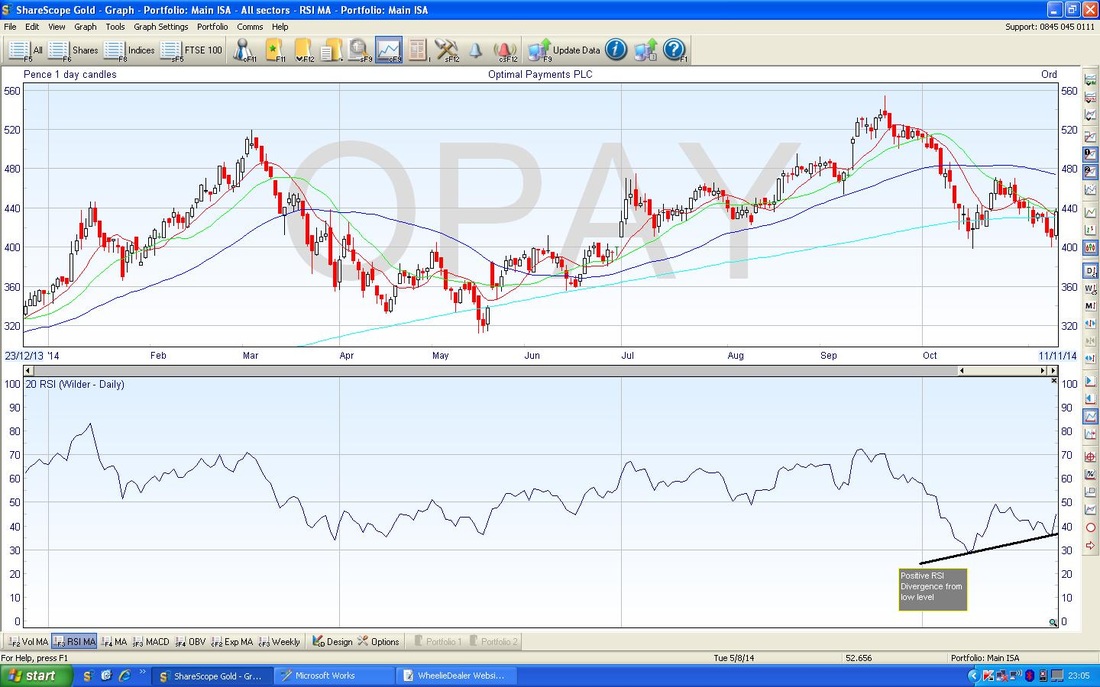|
OK, in Part 3 I promised you Relative Strength Index (RSI) and that’s what I am going to give you - but this is delayed gratification - I am gonna tease you with Moving Averages first - you lucky people…..hmmmm. I love the RSI Indicator - it works really very well - and gives great Signals whether to Buy or Sell. Moving Averages Look at the Chart below. In the Top Window we have the normal Share Price Line with a few coloured meandering lines. The sort of nearly Flat Light Blue Line is the 200 day Simple Moving Average (200 day ma). The Darker Blue Line is the 50 day Simple Moving Average (50 day ma). The Green Line is the 20 day Simple Moving Average (20 day ma) and the Red Line is the 10 day Simple Moving Average (10 day ma). I am only mentioning these lines so you know what they are - but in this Part of the Series I am not intending to dwell on them. However, please just note how the longer the period (number of days) of the MA, the flatter the line is - an often used expression is to say the flatter, longer period, MAs are ‘Slower’. In the same way, the Shorter Period MA lines tend to wiggly around more - they are ‘Faster’. So the 10 day MA is the Fastest and the 200 day MA is the Slowest. I am not much of an expert on MAs - in practice I tend to pay more attention to MACD (Moving Average Convergence Divergence) which I will cover in another Part of the Series. However, there are a few things from this Chart I will point out:
Relative Strength Index (RSI)
The wait is over, you have endured MAs and now I give you your RSI reward……… I love this Indicator - it is just truly brilliant. It is sort of similar to the Momentum Indicator I covered in Part 3. Which reminds me, something I forgot to mention is that a good way of looking at the Momentum Indicator and the RSI is that they both measure the ‘Speed’ of a move. In other words, when we get a bit of an Up Wave (not Elliott’s !!), the Momentum and RSI tells us how Fast it is moving - the ‘Power’ of the Wave or maybe the ‘Force’ of the Wave. Sorry, if that makes no sense, it is hard to explain, but hopefully you will get a sense of what I am saying. Look at the bottom window of the Chart above. Unfortunately it doesn’t really do RSI justice - if you can dig out a Chart elsewhere ( www.advfn.com is a good one) and look at a longer timeframe, you will see that the RSI line tends to move Up and Down (like the Momentum Indicator) between about 30 and 70 according to the Scale on the Right Hand Side. The simple and beautiful logic of RSI is:
The extent of a move will vary from Stock to Stock - I generally find that larger and more liquid stocks and Indexes move quite tightly between 30 and 70 over long periods of time, oscillating up and down. On smaller stocks, with lower liquidity and more extreme moves, you often see them oscillate between as low as 10 and as high as 90. But overall it is a magical indicator and very predictive. So, in light of the above, on the Chart, the RSI had moved down to about 35 and had started to move up when I did my Buy. It was not perfect in that I would prefer to buy on a lower reading (30 or below) but other indicators were flashing ‘BUY’. Remember, I use a combination of Indicators - and not all will perfectly align. RSI Divergence Something rather cool I want to bring your attention to (god, Wheelie, you are such a Geek if you think that is ‘cool’) is the concept of RSI Divergence. It should be quite clear from the Chart - if you look at the Short Thick Black Line I have drawn below the RSI line from the start of October, you will see it slopes quite sharply upwards. If you can enlarge your view of the Chart (Pinch and Expand on Tablet, Fone, or if on PC try pressing ’Ctrl and +’ at same time) you will see the little note I added in Dark Grey. The ‘Positive Divergence’ (or Bullish Divergence would be a better name) arises because although the RSI is sloping upwards (as per the Black Line), the Price Line in the Window above is going sideways - so the RSI Line and the Price Line are moving differently, they are not in Sync. They are Diverging. The beauty here is that such a Bullish Divergence is an Indicator that the Price is about to move up. In this case, there clearly was a Bullish Divergence. Sweet. Hierarchy of Timeliness (HOT - new acronym, I just made it up !!) In our Hierarchy of timeliness that I hinted at in Part 3 I think, RSI comes behind the Momentum Indicator. So the Hierarchy in order of Earliest Warning First so far is:
OK, let’s knock in on the head there. Food time for Wheelie, Bye for now, wd
1 Comment
JonH
16/12/2014 01:54:33 pm
Good article especially on the RSIs. If you have money to invest it is a good indicator to watch to know when to buy
Reply
Leave a Reply. |
'Educational' WheelieBlogsWelcome to my Educational Blog Page - I have another 'Stocks & Markets' Blog Page which you can access via a Button on the top of the Homepage. Archives
January 2021
Categories
All
Please see the Full Range of Book Ideas in Wheelie's Bookshop.
|



